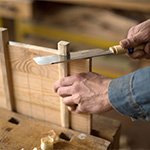Juni . 19, 2024 04:35
Back to list
Wooden pegs in furniture workshops.
The Craft and Commerce of Wooden Nails in Furniture Factories
In the heart of furniture factories, amidst the hum of saws and the whir of sanders, lies a smaller, yet equally important, aspect of craftsmanship the wooden nail. This unassuming fastener plays a crucial role in the construction and durability of wooden furnishings. Let us delve into the significance of these miniature marvels and their journey from raw material to finished product within the walls of furniture factories.
Wooden nails, also known as wood dowels or dowel pins, are cylindrical rods made of wood that serve as a traditional joinery technique. They offer a natural, aesthetically pleasing way to secure pieces of wood together, often used in making chairs, tables, and other types of furniture where a sturdy yet visually seamless connection is desired. Unlike metal screws or nails, wooden nails blend with the grain of the furniture, adding to the organic beauty of the piece.
The process of making wooden nails begins with selecting the right type of wood. Hardwoods such as oak, maple, or birch are preferred for their strength and durability. These woods can withstand the pressure of being driven into place without splitting and provide a long-lasting joint. The selected timber is then cut into thin slices, which are subsequently turned on a lathe to form precise, smooth dowels.
In furniture factories, the production of wooden nails is meticulously integrated into the overall manufacturing process
In furniture factories, the production of wooden nails is meticulously integrated into the overall manufacturing process In furniture factories, the production of wooden nails is meticulously integrated into the overall manufacturing process
In furniture factories, the production of wooden nails is meticulously integrated into the overall manufacturing process
In furniture factories, the production of wooden nails is meticulously integrated into the overall manufacturing process
In furniture factories, the production of wooden nails is meticulously integrated into the overall manufacturing process wooden nails in furniture factories. Once the dowels are formed, they are stored in bins organized by size to ensure ease of access during assembly. When a piece of furniture requires joinery, workers measure and mark where the dowels will be placed, using specialized drilling equipment to create exact holes for a snug fit.
The application of wooden nails involves coating the dowel with wood glue before inserting it into the pre-drilled hole. A special hammer or press is then used to tap the nail into place until it is fully seated, ensuring a tight bond between the two pieces of wood. This method not only provides a strong bond but also allows for disassembly if future repairs or alterations are necessary.
The use of wooden nails in furniture factories is a testament to the enduring nature of traditional craftsmanship in an increasingly automated world. It represents a dedication to quality, sustainability, and the timeless appeal of finely made furniture. As consumers become more conscious of the environment and the origins of their products, the humble wooden nail continues to be an emblem of authenticity and artisanal value in the furniture industry.
wooden nails in furniture factories. Once the dowels are formed, they are stored in bins organized by size to ensure ease of access during assembly. When a piece of furniture requires joinery, workers measure and mark where the dowels will be placed, using specialized drilling equipment to create exact holes for a snug fit.
The application of wooden nails involves coating the dowel with wood glue before inserting it into the pre-drilled hole. A special hammer or press is then used to tap the nail into place until it is fully seated, ensuring a tight bond between the two pieces of wood. This method not only provides a strong bond but also allows for disassembly if future repairs or alterations are necessary.
The use of wooden nails in furniture factories is a testament to the enduring nature of traditional craftsmanship in an increasingly automated world. It represents a dedication to quality, sustainability, and the timeless appeal of finely made furniture. As consumers become more conscious of the environment and the origins of their products, the humble wooden nail continues to be an emblem of authenticity and artisanal value in the furniture industry.
 In furniture factories, the production of wooden nails is meticulously integrated into the overall manufacturing process
In furniture factories, the production of wooden nails is meticulously integrated into the overall manufacturing process
In furniture factories, the production of wooden nails is meticulously integrated into the overall manufacturing process
In furniture factories, the production of wooden nails is meticulously integrated into the overall manufacturing process wooden nails in furniture factories. Once the dowels are formed, they are stored in bins organized by size to ensure ease of access during assembly. When a piece of furniture requires joinery, workers measure and mark where the dowels will be placed, using specialized drilling equipment to create exact holes for a snug fit.
The application of wooden nails involves coating the dowel with wood glue before inserting it into the pre-drilled hole. A special hammer or press is then used to tap the nail into place until it is fully seated, ensuring a tight bond between the two pieces of wood. This method not only provides a strong bond but also allows for disassembly if future repairs or alterations are necessary.
The use of wooden nails in furniture factories is a testament to the enduring nature of traditional craftsmanship in an increasingly automated world. It represents a dedication to quality, sustainability, and the timeless appeal of finely made furniture. As consumers become more conscious of the environment and the origins of their products, the humble wooden nail continues to be an emblem of authenticity and artisanal value in the furniture industry.
wooden nails in furniture factories. Once the dowels are formed, they are stored in bins organized by size to ensure ease of access during assembly. When a piece of furniture requires joinery, workers measure and mark where the dowels will be placed, using specialized drilling equipment to create exact holes for a snug fit.
The application of wooden nails involves coating the dowel with wood glue before inserting it into the pre-drilled hole. A special hammer or press is then used to tap the nail into place until it is fully seated, ensuring a tight bond between the two pieces of wood. This method not only provides a strong bond but also allows for disassembly if future repairs or alterations are necessary.
The use of wooden nails in furniture factories is a testament to the enduring nature of traditional craftsmanship in an increasingly automated world. It represents a dedication to quality, sustainability, and the timeless appeal of finely made furniture. As consumers become more conscious of the environment and the origins of their products, the humble wooden nail continues to be an emblem of authenticity and artisanal value in the furniture industry. Latest news
-
Manufacturer producing brad nails for staple guns with high quality and durability.NewsJul.16,2024
-
CE certification for 5-8mm brad nails and its importance in construction.NewsJul.16,2024
-
Top 16 Gauge Brad Nail Manufacturers with High Quality Products and ServicesNewsJul.16,2024
-
China 18 Gauge Brad Nails for Precision Carpentry Projects in 2021.NewsJul.16,2024
-
Top manufacturer of BN1810 brad nails, providing high quality products for various applications.NewsJul.16,2024
-
Get the job done with 18-gauge staples in 40mm size for various projects.NewsJul.15,2024
